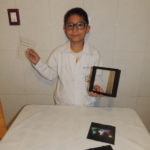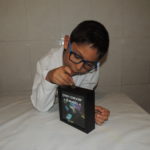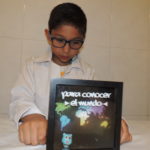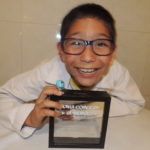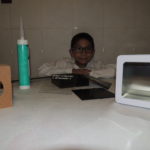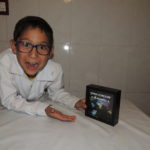Divulgación y enseñanza de la ciencia
EFECTOS VISUALES
- Categoría: Pandilla Kids (3ro., 4to., 5to. y 6to. Año de primaria)
- Área de participación: Divulgación y enseñanza de la ciencia
- Asesor: BRENDA MAYANIN SALINAS RUIZ
- Autor: Victor Emmanuel Burgos Martinez ()
Resumen
A veces no nos damos cuenta que en nuestra vida cotidiana existen muchos efectos visuales como por ejemplo, efectos hace un vidrio con una pequeña curva para ver mejor las cosas, o ahora con las nuevas luces de led para proyectar un color se mezclan, también estos efectos los encontramos en el cine aplicados en el maquillaje y la famosa pantalla verde que todo en conjunto nos da una vista muy diferente, otro ejemplo es muy sencillo y difícil es realizar lo que se llama lenticular estos los vemos muy seguido en publicidad y vasos para niños este método parece que se mueve el dibujo impreso este método se realiza con varias movimientos impresos envueltas en un plástico con muchas rayitas.
Pregunta de Investigación
¿Qué efectos visuales se pueden usar en la vida diaria?Planteamiento del Problema
Existen diferentes tipos de efectos visuales, un ejemplo son los que se aplican en el cine, y siempre me he preguntado si hay efectos visuales que nos ayuden a la vida diaria y como se usan
Antecedentes
Efectos Visuales VFX
Curiosamente casi no encontramos mucho contenido en la biblioteca nos dirigimos al septimo piso y la sopresa, al casi no encontrar cosas para este proyecto.
Así que se encontró con sus origines de los efectos visuales
Principos de los Efectos Visuales
Fotomontaje
LA HISTORIA DEL FOTOMONTAJE
Es un procedimiento y una técnica de fotografía. El término se aplica al proceso y al resultado de crear una imagen compuesta de otras.
Permite alterar el resultado real de una imagen, agregarle una dimensión más extraña, crear situaciones,
paisajes o personajes imposibles.
El fotomontaje es el proceso (y resultado) de hacer una ilustración compuesta de otras, se trata de una especie de collage. Esta composición puede realizarse mediante recortes de otras fotos, mi experiencia personal es: partiendo de una foto que me sirve de base, ir componiendo y seleccionando parte de otras, a las que se le van dando efectos y correcciones, hasta integrarlas en la original. Muchas veces la idea ya la tengo más o menos pensada, pero otras, es como un juego con photoshop, se van originando sobre la marcha.
El fotógrafo inglés Henry Peach Robinson (1830–1901) es acreditado como el primero en realizar esta técnica del fotomontaje, lo hizo al poco de comenzar su carrera en 1857.
Fig. 2 Primer Fotomontaje
“Desvaneciendo”, es una composición de cinco fotos distintas que nos muestra la agonía de una chica enferma de tuberculosis rodeada de su familia.
Oscar Gustave Rejlander
fotógrafo sueco afincado en Inglaterra, nacido en 1813 y muerto en 1875, es considerado uno de los pioneros de la fotografía artística en la época victoriana.
Participó en la Exposición de París de 1855, realizando dos años más tarde su obra más conocida, el trabajo alegórico titulado “Los dos caminos de la vida”. Fue realizada mediante la combinación de 32 negativos.
Exhibida por primera vez en Mánchester, para la realización de la obra empleó fondos pintados y realizó fotografías de los personajes por separado, en parejas, en tríos,.. experimentó con la doble exposición, el fotomontaje, la manipulación y el retoque fotográfico.
Fig. 2 fotomontaje
Efectos Visuales
A principios del siglo XX, George Méliès, ilusionista y cineasta francés filmaba el tráfico de París. El mecanismo de la cámara que utilizaba se atascó pero el tráfico siguió su curso hasta que se logró solucionar la dificultad. Luego, al proyectar lo obtenido por su cámara, vio como un gran bus se transformaba rápidamente en un coche fúnebre.
Se dice que desde ese momento se empezó a escribir la historia de los efectos especiales en el cine, sin despreciar a otros personajes que también aportaron diferentes tipos de efectos, ya que en ese preciso instante, George Méliès descubrió por equivocación el “Stop Trick”. Esto ocurre cuando se filma un objeto y mientras la cámara está apagada, el objeto se coloca fuera de la vista de la cámara y entonces se vuelve a encender. Al ver la película al espectador le parece que el objeto desaparece.
A partir de ahí, Méliès utiliza este truco o efecto en muchas de sus películas, entre ellas VIAJE A LA LUNA (1902) y EL VIAJE IMPOSIBLE (1904), dos de sus películas más conocidas y revolucionarias en su época.
Pero bueno, detengámonos aquí para saber que es en sí un efecto especial.
Los efectos especiales son un conjunto de técnicas utilizadas en el mundo del espectáculo o en el ámbito audiovisual y están destinadas a crear una ilusión audiovisual gracias a la cual el espectador asiste a escenas que no pueden ser obtenidas por medios normales. Los efectos especiales pueden ser usados para la representación de objetos o seres inexistentes. En el cine, también se hace uso de efectos especiales para mejorar elementos reales previamente filmados con medios convencionales.
Existen 5 tipos o 5 formas de clasificar los efectos especiales:
Efectos Ópticos
* Efectos Mecánicos o Animatronics
* Efectos de Sonido
* Efectos de Maquillajes
* Efectos Digitales
Efectos Ópticos
Los efectos ópticos, también llamados visuales o fotográficos, son los más antiguos. Pioneros como Georges Méliès, Segundo de Chomón, Willis O’Brien o Ray Harryhausen fueron los creadores de estas innovaciones.
Estos efectos fueron utilizados en películas como KING KONG, en la cual se acudió a la técnica del Stop Motion y LA GUERRA DE LAS GALAXIAS, donde se utilizaron experiencias más avanzadas basadas en el Stop Motion, llamadas “Go Motion”
Fig 3 Go motion
Fig. 4 Stop motion
Efectos Mecánicos
Mejor conocidos como “Animatronics”, los efectos mecánicos incluyen marionetas mecánicas, escenografía y pirotécnia. Además de ser aquellos con los cuales se crean escenas como la lluvia, disparos, destrucción de edificios, etc. Efectos como estos fueron utilizados en JURASSIC PARK para darle vida a los dinosaurios.
Efectos de Sonido
Los efectos de sonido son todos aquellos obtenidos con sonidos pregrabados, con o sin mezcla entre ellos.
Se utilizan en la mayoría de las películas pero para darles un ejemplo, el sonido del T-Rex de JURASSIC PARK fue hecho mezclando sonidos de elefantes, tigres y lagartos, así como el sonido épico de las armas de LA GUERRA DE LAS GALAXIAS el cual fue captado del sonido de un martillo golpeando cables.
Efectos de Maquillaje
Los efectos especiales de maquillaje toman su nombre del inglés Special Makeup Effects (SPMFX), no son más que prótesis o elementos utilizados en el actor para resaltar sus rasgos, hacer que se vea diferente, o para simular partes falsas del cuerpo. La mayoría de las veces están fabricados en látex.
Se acude a ellos principalmente en filmes de terror como por ejemplo la cara del inmortal Freddy Krueguer o el maquillaje quterror como por ejemplo la cara del inmortal Freddy Krueguer o el maquillaje que utilizan los actores en películas de zombies.
Fig. 5 Maquillaje
Efectos Digitales
Los efectos digitales también designados como infografías o imágenes generadas por computadora son todas aquellas imágenes digitales que se crean por ordenador aunque también pueden ser imágenes reales retocadas por ordenador, con composición o proceso de integración de todas ellas.
Efectos Visuales
Los efectos Visuales se pueden dividir en dos categorías: ópticos y mecánicos.
Los efectos ópticos se realizan mediante la manipulación de la cámara y la iluminación que a su vez hará que la escena adquiera un aspecto diferente de lo que parece a simple vista. Esto podría implicar trabajar con diferentes objetivos y filtros, tipos de iluminación, o movimientos de cámara que juegan con el ojo humano y consiguen el efecto deseado.
El director de fotografía y el supervisor de efectos especiales son los encargados de asesorar al realizador y al director en el set para lograr lo que se desea.
Cada tipo de especialista se implica en trabajar durante el rodaje en vivo y por lo general se refiere a hacer que las cosas parezcan algo que no son. Por ejemplo la manipulación de las condiciones climáticas como el viento y la nieve es una gran parte de los efectos mecánicos. Pirotecnia y trabajar con modelos a escala es otro aspecto de efectos mecánicos.
Los efectos visuales se han convertido en una parte fundamental de lo que es la realización de películas. Como decíamos al inicio del artículo, actualmente es difícil encontrar una película de éxito que no haga uso de los efectos visuales.
Estos efectos se realizan mediante la creación de imágenes (CGI), 3D o animación generada por ordenador.
El supervisor de efectos visuales toma todas las decisiones creativas y trabaja directamente con el director para asegurarse de que se consigue la imagen deseada.
Fig. 6 Efectos Visuales Digitales







Objetivo
Investigar y difundir de los efectos visuales y la implementación de estos en la vida diaria
Justificación
Me interesa el tema ya que me gustan los efectos visuales y quería saber si existen este tipo de efectos en nuestra vida diaria y como se aplican, si pueden ayudar a las personas
Además de investigar que implementación llevan tales efectos para lograr captar la atención de las personas
Hipótesis
Si realizamos una caja mágica entonces podemos demostrar la creatividad que se encuentra en los efectos visuales
Método (materiales y procedimiento)
MATERIALES
Caja de fibracel o madera
Pistola de silicón
Barra de silicón
Una mica transparente
Una imagen decorativa
Broca de 1/8”
Taladro
Pegatinas al gusto
-Se realizará una caja con una vista de frente con una mica en ella se llevará a cabo el efecto visual para poner una moneda en la parte de arriba y no aparecerá en la caja
PROCEDIMIENTO
- Se empieza por ensamblar para hacer la caja haciendo las paredes con el fibracel
- Se empieza a pegar todo con silicón ya armando la caja
- Se pega la mica haciendo una ventana para que la gente vea el efecto
- Con la ayuda de un adulto se ranura la parte superior para hacer la entrada de la moneda con la broca y el taladro
- Una vez armada se puede decorar el interior de la caja
- Posteriormente se coloca en el interior de la caja la imagen con la que se pretende hacer el efecto o se puede poner un vidrio para tener un mejor efecto
- Se puede decorar la caja al gusto para que se vea lo más bonita posible
- Al final se pone una moneda en la ranura para que verifiquemos que nuestro efectos visual si funciona
Resultados
Al final quedo una caja muy bonita para hacer la explicación de los efectos visuales en si es muy sencilla construirla pero si se necesita de la ayuda de un adulto porque hay cosas que no se pueden hacer bien con hacer la entrada de las monedas y billetes porque si no se hace bien no se ve bonita la caja, además de saber como se usa la pistola para silicón por que se pone muy caliente y puedes tener un accidente de quemarte y que también que un adulto verifique que no tengan filo el espejo para que uno no se llegue a cortar y estos materiales se deben de utilizar con mucho cuidado ya que si se rompen podemos cortarnos muy feo, ya la decoración fue de los más sencillo se puede pintar o poner pegatinas si te gustan los transformer como yo puedes imprimir en tu casa o ver si en la papelería tienen pegatinas y decorarla a tu gusto, al final si resulto nuestro proyecto y me gusto como quedo
Discusión
Conclusiones
Pudimos comprobar que con un poco de imaginación se pueden crear cosas nuevas e inimaginables para alcance de nuestros sentidos, se pudo realizar esta caja mágica y dar una explicación de los que son los efectos visuales.
Bibliografía
Edición digital de la imagen y efectos especiales
Autor Michael Freeman editorial Bloom
Arte cinematográfico autor David bordwell, Editorial graw Hill
Producción de videos autor Tomás burroughs, Editorial blume
https://es.wikipedia.org/wiki/Efectos_visuales
EFECTOS VISUALES
Summary
Sometimes it doesn’t give us that in our everyday life there are many Visual effects as effects for example, does a glass with a small curve to see things better, or now the new led lights to project a color mix, also these effects the in contramos in the cinema in the makeup and the famous Green screen all together gives us a very different view, another example is very simple and difficult it is to perform what is called lenticular these see them very often in advertising and glasses for children this method p arece that it moves the printed drawing this method is done with several printed movements wrapped in plastic with many hairlines.
Research Question
What visual effects can be used in daily life?Problem approach
There are different types of Visual effects, an example are those who apply in the cinema, and have always wondered if there is Visual effects that help us to daily life and how they are used.
Background
The following background your obtained through the visit to the library Vasconcelos located in the CDMX
Fig, 1 Biblioteca Vasconcelos
BACKGROUND
Visual effects VFX
Interestingly almost did not find much content on the library headed to the seventh floor and the surprise, almost not to find things for this project.
So was found with its origins of Visual effects
Principles of Visual effects
Photomontage
THE HISTORY OF PHOTOMONTAGE
It is a procedure and a technique of photography. The term is applied to the process and the result of creating an image composed of others.
It allows you to alter the actual result of a picture, add a dimension more strange, create situations,
landscapes or impossible characters.
Photomontage is the process (and result) make an illustration consisting of others, it’s a kind of collage. This composition can be done through cuts in other photos, my personal experience is: starting from a photo that I used as basis, go to composing and by selecting part of others, who you’ll give effects and corrections, to integrate them in the original. Many times the idea already I have more or less thought out, but others, is as a game with photoshop, are creating on the fly.
The English photographer Henry Peach Robinson (1830-1901) is credited as the first to perform this technique of photomontage, did shortly after beginning his career in 1857.
Fig. 2 first photomontage
“Fading” is a composition of five different photos which shows us the agony of a girl sick with tuberculosis, surrounded by his family.
Oscar Gustave Rejlander
Swedish photographer based in England, born in 1813 and died in 1875, is considered one of the pioneers of art photography in the Victorian era.
He participated in the Paris exhibition of 1855, performing two years later his best-known work, the allegorical work entitled “The two ways of life”. It was created by combining 32 negatives.
Exhibited for the first time in Manchester, for the realization of the artwork used painted wallpaper and made photographs of the characters separately, in pairs, trios, in… He experimented with double exposure, photomontage, manipulation and photo retouching.
Fig. 2 montage
Visual effects
At the beginning of the 20th century, George Méliès, illusionist and French filmmaker shooting Paris traffic. The mechanism of the camera that I used got stuck but traffic continued its course until it managed to resolve the difficulty. Then, when projecting the retrieved by your camera, saw a big bus was quickly transformed into a hearse.
It is said that from that moment he began to write the history of special effects in the film, without neglecting other characters who also provided different types of effects, since at that precise moment, George Méliès discovered by mistake the “Stop Trick” . This occurs when an object is shot while the camera is off, the object is placed out of sight of the camera and then turns on again. To see the movie to the Viewer it seems that object disappears.
Starting from there, Méliès used this trick or effect in many of his films, among them a trip to the Moon (1902) and the journey impossible (1904), two of his most famous and revolutionary films in his time.
But well, let’s stop here to know what is a special effect.
The special effects are a set of techniques used in the world of the show or in the audiovisual field and are intended to create an audio-visual illusion thanks to which the viewer attends scenes that can not be obtained by normal means. Special effects can be used for the representation of objects or non-existent beings. In the film, is also makes use of special effects to improve real elements previously filmed with conventional means.
There are 5 types or 5 ways to classify special effects:
Optical effects
* Mechanical effects or Animatronics
* Sound effects
* Make-up effects
* Digital effects
Optical effects
Visual or photographic, optical, also called effects are the oldest. Pioneers such as Georges Méliès, Segundo de Chomón, Willis O’Brien and Ray Harryhausen were the creators of these innovations.
These effects were used in films such as KING KONG, which went to the technique of Stop Motion and the wars, where used more advanced experiences based on the Stop Motion, calls “Go Motion”
Fig 3 Go motion
Fig. 4 stop motion
Mechanical effects
Better known as “Animatronics”, mechanical effects include mechanical puppets, scenery and Fireworks. As well as being those which create scenes like the rain, shooting and destruction of buildings, etc. Effects like these were used to give life to the dinosaurs in JURASSIC PARK.
Sound effects
The sound effects are all those obtained with pre-recorded sounds, with or without mix among them.
They are used in most of the films but to give an example, the sound of the T-Rex from JURASSIC PARK was made by mixing sounds of elephants, Tigers and alligators, as well as the epic sound of weapons of the wars which was recruited by the sound of a Martí llo hitting cables.
Effects of makeup
Special makeup effects take their name from the English Special Makeup Effects (SPMFX), are nothing more than prosthetic or elements used in the actor to highlight its features, make it look different, or to simulate fake body parts. Most of the time are made of latex.
Goes to them mainly in films of terror such as the face of the immortal Freddy Krueguer or makeup quterror as for example the face of the immortal Freddy Krueguer or makeup that actors use in films zombies.
Fig. 5 makeup
Digital effects
The digital effects also designated as computer graphics or computer-generated images are all those digital images that are created by computer but they can also be actual pictures retouched by computer, with composition or process of integration of all of them.
Visual effects
Visual effects can be divided into two categories: optical and mechanical.
Optical effects are made by manipulating the camera and lighting which in turn will make the scene to acquire a different aspect of what appears at first glance. This could involve working with different objectives and filters, types of lighting and camera movement that play with the human eye and get the desired effect.
Director of photography and special effects supervisor is responsible for advising the Director and director on the set to achieve what you want.
Each type of specialist is involved in work during the filming live and usually refers to make things look like something they are not. For example the manipulation of the weather as the wind and snow is a large part of the mechanical effects. Pyrotechnics and working with scale models is another aspect of mechanical effects.
Visual effects have become an essential part of which is the realization of films. As we said at the beginning of the article, it is currently difficult to find a successful film which does not make use of Visual effects.
These effects are done through the creation of images (CGI), 3D or computer-generated animation.
Visual effects supervisor takes all the creative decisions and works directly with the director to ensure that you get the desired image.
Fig. 6. digital Visual effects






Objective
To Investigate and announce the visual effects and their implementation in daily life
Justification
I am interested in the topic since I like Visual effects and wanted to know if there are such effects in our daily life and as apply, if they can help people
In addition to investigate implementation to carry such effects to capture the attention of people
Hypothesis
If we design a magic box then we can show the creativity that we can find in Visual effects
Method (materials and procedure)
MATERIALS
Fibracel or wood box
Silicone gun
Silicone bar
A transparent mica
A decorative image
1/8 “drill bit
Drill
Stickers to taste
-Will be a box with a view from the front with a mica in it carry out the visual effect to put a coin on the top and will not appear in the box
PROCEDURE
- You begin by assembling to make box making the walls with the fibracel
- It begins to paste everything with silicone because armando box
- Sticking the mica making a window for people to see the effect
- With the help of an adult is slot the top to make the entrance of the currency with the drill bit and drill
- Once assembled you can decorate the inside of the box
- Subsequently is placed on the inside of the box image which is intended to make the effect or a glass can be to have a better effect
- You can decorate the box to taste to make it look as nice as possible
- At the end gets a coin in the slot so that we can check that our effects visual if it works
Results
At the end was a nice box to make the explanation of Visual effects in if it is very simple to build it but if you need an adult’s help because there are things that cannot be well with make the entrance of coins and banknotes because failure to do bie n is not pretty box, as well as know how to use the gun for silicone that becomes very hot and you can have an accident you burn and also that an adult check that they do not have edged mirror that one may not cut and these materials are they should use with care because if they break we can cut ourselves very ugly, the decoration was of the simplest you can paint or put stickers if you like the transformer as I can print on your home or can do so in the stationery stickers and decorate it to your taste, in the end turned out to our project and me like I am
Discussion
Conclusions
We saw that with a little imagination is they can create new and unimaginable things for scope of our senses, could perform this magic box and give an explanation of the Visual effects.
Bibliography
Edición digital de la imagen y efectos especiales
Autor Michael Freeman editorial Bloom
Arte cinematográfico autor David bordwell, Editorial graw Hill
Producción de videos autor Tomás burroughs, Editorial blume
https://es.wikipedia.org/wiki/Efectos_visuales

